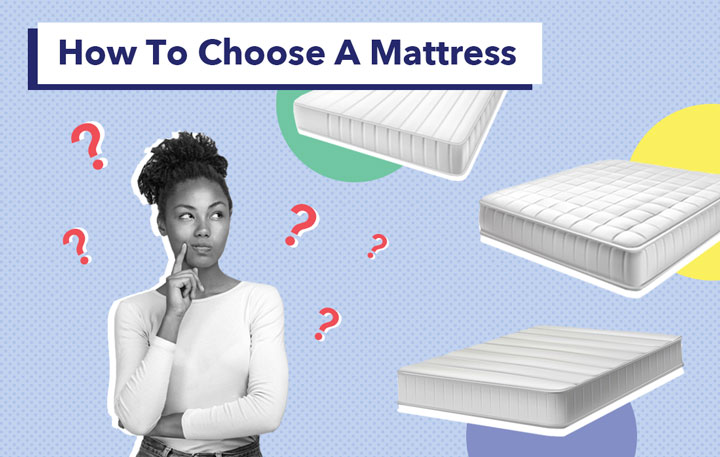How to Choose the Right Mattress for Your Sleep Needs

This article presents a comprehensive guide on selecting an appropriate mattress to meet individual sleep needs. It explores various factors that should be considered, such as understanding one’s sleep requirements and the different types of mattresses available.
The article also delves into the importance of finding the right firmness level and provides recommendations on testing and comparing mattresses.
By adhering to the principles of objectivity and impartiality, readers can make informed decisions when choosing a mattress that suits their individual preferences and sleep patterns.
Key Takeaways
- Consider your sleeping position and choose a mattress with the appropriate firmness level for proper spinal alignment and pressure relief.
- Understand the different types of mattresses available (such as memory foam, innerspring, latex, and hybrid) and select the one that best suits your needs and preferences.
- Test and compare mattresses by considering factors such as material type, motion isolation, cooling technologies, comfort, support, price, value, and durability.
- Create a sleep-friendly environment by taking into account factors such as room temperature, noise levels, lighting, and specific mattress features that can address sleep disorders.
Factors to Consider
One factor to consider when choosing a mattress for sleep needs is the level of firmness. The firmness of a mattress is important because it can affect the overall comfort and support provided during sleep.
Different sleeping positions require different levels of firmness to ensure proper spinal alignment and pressure relief. For example, side sleepers may prefer a softer mattress that contours to their body’s curves and relieves pressure points. On the other hand, back and stomach sleepers may benefit from a firmer mattress that provides more support to maintain proper alignment.
Additionally, the materials used in the mattress can also influence its firmness. Memory foam mattresses tend to be softer and more contouring, while innerspring mattresses are generally firmer and offer more bounce.
Therefore, understanding one’s sleeping position and considering the mattress materials can help in selecting the appropriate level of firmness for optimal sleep comfort.
Understanding Your Sleep Needs
This discussion will focus on two key points: sleep patterns and preferences, and factors affecting sleep quality.
Understanding sleep patterns and preferences involves examining individual variations in sleep duration, timing, and depth, as well as the influence of environmental and cultural factors.
Additionally, factors affecting sleep quality encompass a wide range of variables, including physical health, psychological well-being, lifestyle choices, and sleep environment.
Sleep Patterns and Preferences
Sleep patterns and preferences play a crucial role in determining the suitability of a mattress for an individual’s sleep needs. Understanding one’s sleep patterns can help identify any underlying sleep disorders that may require specific mattress features. For example, individuals with sleep apnea may benefit from a mattress that elevates the head and neck to promote better breathing during sleep.
Additionally, considering one’s sleep environment is important when selecting a mattress. Factors such as room temperature, noise levels, and lighting can influence sleep quality and comfort. A mattress that provides temperature regulation, motion isolation, and pressure relief can contribute to a more conducive sleep environment.
By taking into account sleep patterns and preferences, individuals can choose a mattress that best supports their unique sleep needs.
- A mattress that contours to the body’s shape
- A mattress that offers firm support for proper spinal alignment
- A mattress that minimizes motion transfer for undisturbed sleep
Factors Affecting Sleep Quality
Factors such as noise levels, room temperature, and lighting can significantly impact an individual’s sleep quality. Environmental factors play a crucial role in determining the quality and duration of sleep. Sleep disorders, such as insomnia and sleep apnea, can be influenced by these factors, making it essential to create a conducive sleep environment. Noise disturbance, whether from external sources like traffic or internal sources like snoring partners, can disrupt sleep patterns. Room temperature also plays a significant role, as extreme temperatures can make it difficult to fall asleep or stay asleep. Additionally, lighting conditions, especially bright or artificial light, can interfere with the body’s natural sleep-wake cycle. Creating a sleep-friendly environment by addressing these environmental factors can improve sleep quality and reduce the risk of sleep disorders.
| Environmental Factors | Effects on Sleep Quality |
|---|---|
| Noise levels | Disrupt sleep patterns |
| Room temperature | Inhibit falling asleep |
| Lighting conditions | Interfere with sleep-wake cycle |
Different Types of Mattresses
One essential aspect to consider when selecting a mattress is the various types available in the market. Understanding the different types of mattresses can help individuals make an informed decision based on their specific needs and preferences.
Two popular types of mattresses are memory foam and innerspring.
- Memory foam mattresses: These mattresses are known for their ability to conform to the shape of the body, providing excellent support and pressure relief. They are made from a viscoelastic material that reacts to body heat and weight, allowing for a customized sleeping experience.
- Innerspring mattresses: These mattresses have a core of steel coils that provide support and durability. They are known for their responsiveness and bounce, making them a good option for those who prefer a firmer surface.
Finding the Right Firmness Level
Understanding the firmness level that best aligns with an individual’s preferences and comfort requirements can contribute to selecting an appropriate mattress. Finding the right firmness level involves considering factors such as body weight, sleeping position, and personal preference.
Mattress materials and construction play a crucial role in determining the firmness level. Different mattress types, such as memory foam, innerspring, latex, and hybrid, offer varying levels of firmness.
Memory foam mattresses, known for their contouring properties, typically provide a medium to firm level of support. Innerspring mattresses, on the other hand, tend to offer a range of firmness options, from soft to firm. Latex mattresses often provide a medium to firm support, while hybrid mattresses combine the benefits of different materials to offer a customizable firmness level.
It is essential to carefully consider these aspects to ensure optimal comfort and support for a good night’s sleep.
Testing and Comparing Mattresses
This discussion will focus on three key points when it comes to testing and comparing mattresses:
- Key mattress features:
- Factors such as the type of material used
- The level of motion isolation
- The presence of cooling technologies
Comfort and support are essential aspects to consider, as they determine how well a mattress conforms to the body and provides proper spinal alignment.
- Comfort and support:
- How well a mattress conforms to the body
- Provides proper spinal alignment
Lastly, price and value play a crucial role in decision-making, as consumers need to weigh the cost of a mattress against its quality and durability.
- Price and value:
- Weighing the cost of a mattress against its quality and durability.
Key Mattress Features
A thorough consideration of key mattress features is crucial when selecting the right mattress to meet one’s sleep needs.
Two important factors to consider are mattress durability and mattress materials.
- Mattress durability: A durable mattress is essential for long-term use. It should be able to withstand regular wear and tear without losing its supportive properties. Look for mattresses with strong edge support and high-quality materials that are resistant to sagging and indentations over time.
- Mattress materials: The materials used in a mattress can greatly affect its comfort and support. Common mattress materials include memory foam, latex, innerspring, and hybrid. Each material has unique properties that cater to different sleep preferences. For example, memory foam provides excellent pressure relief, while latex offers natural breathability. It is important to consider one’s individual preferences and needs when choosing the right mattress material.
Comfort and Support
After considering key mattress features, the next aspect to examine when choosing the right mattress is comfort and support.
Comfort refers to the overall feel of the mattress, while support refers to how well it maintains proper spinal alignment. Both of these factors are crucial for a good night’s sleep.
A mattress should provide adequate pressure relief, contouring to the body’s shape and distributing weight evenly. This helps to alleviate pressure points and reduce discomfort.
Additionally, temperature regulation is important for optimal sleep. Some mattresses are designed with cooling materials or technologies to dissipate body heat and promote a cooler sleeping environment. These features can prevent overheating and improve sleep quality, especially for individuals who tend to sleep hot.
Overall, comfort and support, along with pressure relief and temperature regulation, play significant roles in selecting the right mattress for one’s sleep needs.
Price and Value
Price and value are important factors to consider when evaluating different mattresses. One’s budget constraints play a significant role in determining the affordability of a mattress. However, it is crucial to strike a balance between price and quality. Durability and longevity are also essential considerations. A durable mattress can withstand wear and tear over time, ensuring its longevity and value for money.
When evaluating mattresses, it is helpful to keep in mind the following:
- Comfort: A mattress that provides optimal comfort and support promotes a restful sleep.
- Materials: The type of materials used in the construction of the mattress can affect its durability and lifespan.
- Warranty: A warranty indicates the manufacturer’s confidence in the mattress’s quality and may provide protection against defects.
Considering these factors allows individuals to make informed decisions when selecting a mattress that best fits their needs and budget constraints.
Making an Informed Decision
To make an informed decision when choosing a mattress for your sleep needs, it is important to consider factors such as mattress type, firmness level, and material composition.
The mattress material and its impact on the sleep environment are crucial aspects to consider. Different materials offer different levels of support and comfort. For example, memory foam mattresses conform to the body’s shape and provide excellent pressure relief. Latex mattresses, on the other hand, offer a more responsive and bouncy surface.
In terms of sleep environment, materials such as memory foam and latex are known for their ability to absorb motion, making them suitable for couples or individuals who share a bed. Additionally, some materials are hypoallergenic and resistant to dust mites, making them ideal for those with allergies or asthma.
Therefore, understanding the impact of mattress material on the sleep environment is essential in making an informed decision.
Frequently Asked Questions
How Often Should I Replace My Mattress?
The frequency of replacing a mattress depends on various factors such as the quality of the mattress, usage patterns, and individual preferences. Signs of a worn-out mattress include sagging, discomfort, and a decrease in sleep quality.
Can I Use Any Type of Mattress on an Adjustable Bed Frame?
The pros and cons of using an adjustable bed frame should be considered when deciding on a mattress. Different types of mattresses are compatible with adjustable bed frames, each with their own advantages and disadvantages.
Are Memory Foam Mattresses Suitable for People With Allergies?
Memory foam mattresses may not be suitable for people with allergies. Latex mattresses are often considered hypoallergenic due to their resistance to dust mites and mold. Innerspring mattresses, on the other hand, may not provide the same level of protection against allergens.
Can I Sleep on a Mattress as Soon as It Is Delivered, or Does It Need Time to Expand?
The time required for a mattress to expand after delivery can vary depending on the type and materials used. It is recommended to follow the manufacturer’s instructions to ensure optimal performance and comfort.
What Is the Warranty Period for a Mattress and What Does It Cover?
The warranty period for a mattress varies depending on the manufacturer and model. It typically covers defects in materials and workmanship, but may not cover normal wear and tear or damage caused by misuse.









